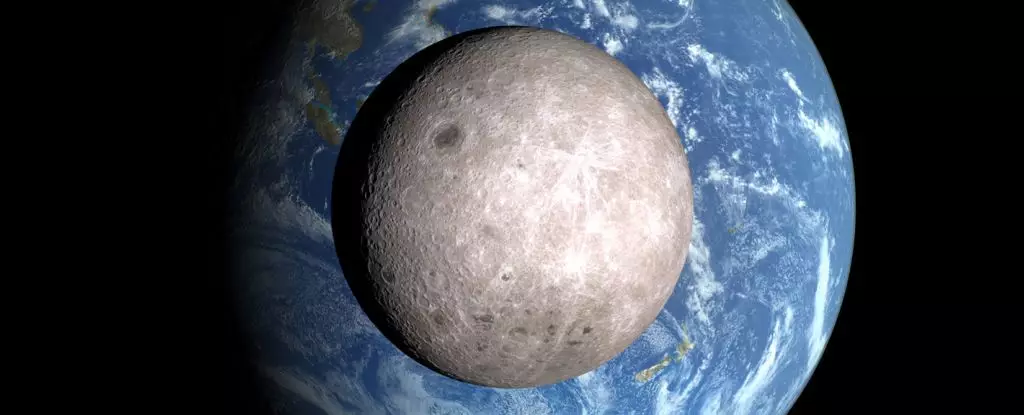The Moon, Earth’s ancient companion, holds secrets that transform our understanding of cosmic evolution and planetary formation. The latest research into the Moon’s water distribution reveals a striking asymmetry, challenging previously held assumptions about our celestial neighbor. Lunar samples from the enigmatic far side have uncovered that this hemisphere contains significantly less water compared to the side that perpetually faces Earth. This disparity goes beyond mere curiosity; it offers a glimpse into the Moon’s dynamic history and how it relates to the larger narrative of our solar system’s origins. In our quest to understand celestial bodies, the intricacies of the Moon’s uneven geological makeup raise more questions than they answer.
Contrasting Landscapes: Near Side vs. Far Side
When observing the Moon, the differences between its two hemispheres are impossible to ignore. The near side, visible from Earth, is dominated by expansive, smooth plains known as maria, formed from historical volcanic activity. In stark contrast, the far side is draped in a rugged cloak of craters—a silent testament to a tumultuous past. This disparity invites a slew of hypotheses aimed at accounting for the Moon’s patchy exterior. Central to this discourse is the idea that the Moon’s formation involves a complex interplay of impacts and geological processes, suggesting that our satellite is much more than a simple rock orbiting Earth.
The prevailing theory posits that the Moon was formed from debris ejected into orbit by a colossal collision over 4.5 billion years ago. The size and nature of this event could help decode the asymmetries we observe today. For example, the thinner crust on the near side may have been influenced by Earth’s gravitational heat, while the far side cooled more uniformly, leading to the stark differences in surface features. Thus, the Moon’s water distribution might reflect its fiery beginnings—a narrative written in the cosmic dust of creation.
Water’s Role in Planetary Formation: More Than Meets the Eye
Water is often heralded as the essence of life, but its significance extends into the realms of geology and planetary science. The findings from the Chang’e-6 mission, which successfully brought samples back from the Moon’s far side, have important implications for our understanding of lunar history and planetary development. The absence of water in the far side’s lunar mantle challenges long-standing theories about how celestial bodies evolve through massive impacts.
A critical piece of evidence comes from the analysis conducted by planetary physicists Huicun He and Linxi Li, whose work sheds light on the elemental composition of the Moon. Their findings indicate that the South Pole-Aitken Basin, one of the Moon’s largest impact structures, exhibits minimal water content—merely 1 to 1.5 micrograms per gram of rock. Such revelations hint at harsher conditions in this part of the Moon, with potential limitations on volcanic activity and, consequently, water distribution. The implications of this research resonate beyond the Moon, challenging our understanding of how volatile elements behave during the chaotic formation of planetary systems.
Exploring the Asymmetry: Insights into Celestial Formation
The intriguing question arises: why does the far side of the Moon have such a low water concentration? Some scientists speculate that the cataclysmic impact that created the South Pole-Aitken Basin could have displaced material toward the near side. This line of reasoning suggests that the peculiar distribution of resources on celestial bodies is not a mere accident but could instead stem from the history of violent interactions in the cosmos.
The fact that researchers have only scratched the surface—literally and figuratively—with a handful of lunar samples means the tale of the Moon is still being written. Each new analysis builds upon existing theories, pushing the boundaries of what we understand about lunar geology. As researchers propose that there may still exist wetter regions within the Moon’s far side, the need for further exploration becomes paramount. Understanding the Moon’s chemical composition can illuminate how planetary systems develop—signaling that our quest for knowledge is just beginning.
The Call to Action: Why We Must Investigate Further
The excitement of lunar studies encapsulates the pioneering spirit of scientific inquiry. As we uncover the motivations behind the Moon’s unique characteristics, the narrative expands to encapsulate the ongoing dialogue about planetary evolution and formation. The disparities in water distribution are not mere scientific curiosities; they have profound implications for understanding not only our Moon but also the genesis of other planetary bodies in our solar system and beyond.
With renewed interest in space exploration, the prospect of launching future missions to collect more lunar samples is tantalizing. As humanity stands on the brink of further discoveries, the Moon beckons us to probe its mysteries, promising deeper insights that could redefine our place in the universe. The Moon is not just a rock; it is a historical archive waiting to be deciphered, a testament to the powerful events that shaped our solar system—igniting our curiosity and demanding that we push the limits of our exploratory capabilities.



Leave a Reply